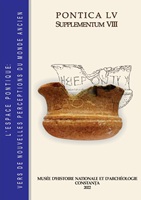On the Symbolism and the Monetary Function of the West Pontic Pre-monetary Signs
On the Symbolism and the Monetary Function of the West Pontic Pre-monetary Signs
Author(s): Florina Panait-BîrzescuSubject(s): Archaeology, Cultural history, Visual Arts, Economic history, Social history, Ancient World, History of Art
Published by: Muzeul de Istorie Națională și Arheologie Constanța
Keywords: arrowhead-shaped signs; Apollo; Apollonia; Histria; Borysthenes; Olbia;
Summary/Abstract: The article discusses two related aspects of the monetary signs issued by the Milesian apoikiai from the West and Northwest coast of the Black Sea: Borysthenes, Olbia1 , Histria and Apollonia: the symbolic meaning and the monetary function. A part of these pieces were cast in arrowheads moulds, usually labelled Scythian arrowheads, because of the occurrence of this type of items mainly in the North-western Pontic area. Although these represent a small percentage of the total discoveries of monetary signs, it is one of the main arguments of the theory regarding a supposed symbolic meaning that the native populations would have attached to them, and as a result the main reason for which the Greeks have chosen this particular local form for their first monetary issues. This reasoning follows the theory according to which the necessity for foreign trade had a decisive role in the appearance of the currency. Henceforth, regardless of another explanation that points to the close connection between the symbolic meaning of both types of monetary signs (arrowheads and leaves) and the main deity of the three issuing cities, Apollo Ietros, which remained marginal throughout the discussion, these were understood from the viewpoint of those, whom the main concern were the relations between Greek colonies and the native populations. The paper presents the faults of this theory: both the theoretical framework and the interpretation of the sources brought as arguments are scrutinized. The first problem regards the monetary function of the non-functional signs, when these are put in the wider context of the beginning of the bronze currency in general. Not only it hardly fits in the Greek context, when considering its early occurrence, but in the native one is even more problematic; which justify above all the name of monetary signs. However the excess of fixed conventional value given to a piece of base metal, and the collective trust needed for its acceptability are the main features of the Greek coin during the Archaic and the Classical periods. This are also features of the non-functional arrowheads and leaves of bronze. The observation supports the already acknowledged monetary function that was recognised in the function of means of exchange that justify hoarding, and also in their later association with bronze coins (e.g. of the wheel type at Histria). Furthermore it is argued that since these monetary features are embedded in the practice of reciprocity and distribution in the ritual of sacrifice, the origin of the WestPontic monetary signs should rather be searched for in cult. The ambivalence of the form, visible in the coexistence of the two types, but also in the ambiguity of most of the signs, the leaf and the arrowhead shape being hard to distinguish in one and the same piece, corresponds to the ambivalence of the two Apollonian attributes: arrow and branch, expressions of the twofold divine powers of Apollo in general, and of Apollo Ietros especially, namely to send the plague, and to cure it. Furthermore the arrowheads are symbolic offerings, among other weapons and armour items commonly dedicated to Apollo during Archaic period, as reminders of the warrior-athletic virtues prized in contests during his festivities. The paper continues by showing that from votive symbolic offering to payment for the god was a small step to make, anticipating the emergence of the proper currency. This episode is understandable only in the context of the Milesian colonisation. If Miletus, among other Ionian cities, had a key role in the emergency of the coin made of valuable metal (EL), it was its oversea settlements that made the next step to the bronze coin in arrowhead/leaf shape. Already familiarized with a monetized society from their mother-city, and no more conditioned by old trade customs that valued the precious metal in coins, the Ionian settlers come up with this solution for some internal needs related, at least in an earlier phase, to the well-functioning of the cult of their main deity, Apollo Ietros. The shared monetary symbol is a proof not only of their common origin, but mainly of a union of common interest. The advantages of this development attracted also the local population. It was not a failed attempted, but a successful one that lasted a century, being afterwards replaced with an updated product – the coin of bronze and of silver.
Journal: Pontica
- Issue Year: 2022
- Issue No: 55 SppVIII
- Page Range: 149-171
- Page Count: 23
- Language: English

